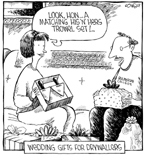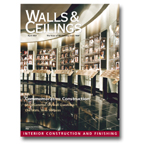

Not so simple
It is indeed disappointing to discover that two serious efforts to redress decades of acoustical neglect in the design and building of classrooms are being ridiculed by a person who could have offered constructive support and criticism in both endeavors.In his commentary, "Classroom Acoustics: A Review," published in the April 2001 issue of Walls & Ceilings, Jon W. Mooney criticizes the ANSI technical committee on classroom acoustics for fiddling while Rome burns. However, his main target is "Classroom Acoustics," a recent brochure published under the aegis of the Acoustical Society of America. This latter is compared to a set of Cliffs Notes because of what Mr. Mooney perceives as over-simplification and lack of details.
It is clear that this critic has some understanding of the subject. He believes that, on one hand, the national standard should have been finalized long ago while on the other, the ASA brochure should have been more rigorous in its handling of a widely misunderstood subject. Why, as a member of the Acoustical Society, he did not avail himself of the opportunity to make a worthwhile contribution to both studies is less clear.
However, when viewed in its historical context two simple facts emerge, against which these criticisms pale into insignificance:
1. As documented in the March 1999 report of the U.S. Access Board, an alarmingly high proportion of existing classrooms in the United States do not provide good hearing conditions.
2. This situation is being perpetuated daily due either to ignorance or to the lack of concern for acoustical conditions. This tendency appears to be widespread throughout the design professions and at all levels of the building industry.
This lack of concern was recognized long ago, as indicated in an impressive but largely forgotten 1958 book called "Schoolhouse" on the design of new U.S. schools where author Walter McQuade wrote, "Classrooms may be noisy simply because of the way they are constructed and finished. This is perhaps the most common fault in new schools. It is a shocking fault, for the need to hear well is basic in education."
Since its inception in 1929, the Acoustical Society of America, in common with affiliated societies worldwide, has been instrumental in defining objective criteria for good hearing and in pursuing standards for the design of buildings of all types. Unfortunately, much of this work is recorded in technical publications that have tended to be difficult to translate into the common parlance of bricks and mortar.
However, beginning with Professor Sabine's initial presentation on architectural acoustics in 1898 to the American Institute of Architects, a great deal of information has also been deliberately presented in simpler terms. It has thus been readily available, not only to building professionals, but also to members of school boards and to the parents whose children must endure the builders' mistakes. The ASA brochure is a directly targeted version of this long-standing effort to remind anyone who is interested that classrooms can be improved with little cost or effort.
The proposed ANSI standard for classroom acoustics, which has been spurred in large part by concerned hearing specialists and parents of children with marginal hearing, has naturally attracted a very broad spectrum of interests. That the dialogue about classroom acoustics has gone on for so many decades is certainly unfortunate.
The fault is not in our actions but in our late start. This brochure goes a long way to help all stakeholders catch up on the importance of good classroom acoustics to all students and the relative ease with which it can be achieved.
The ASA brochure has been simplified by intent so that as wide an audience as possible may read and appreciate the few simple facts that are needed to correct poor acoustics and to avoid a recurrence. It includes a substantial bibliography for anyone with the interest to explore further. Its purpose is to draw upon the lifetime experience of the reader and to focus it on a specific need. The precise and repeatable predictions available from computer programs are far less convincing to a non-technical person than a simple experiment can be. For example, hanging several strips of ordinary glass fiber building insulation around the walls of a reverberant classroom will allow even the least-educated person to hear an improvement.
That the concise and superbly stated "requirements for good hearing" from Sabine's 1898 presentation have not been fully integrated into the building design process is a source of great frustration to their exponents, and also a source of revenue to many acoustical consultants.
As one who has devoted a professional career to consultation on building design and teaching architects about acoustics--while I can appreciate much of Mr. Mooney's discourse--I can only hope that he will see fit to channel his efforts in a more constructive direction.
Ewart A. Wetherill, AIA FASA
Shen Milsom & Wilke/Paoletti
San Francisco
Dear Dr. Wetherill,
Thank you for your critique of my critique. My complaint of the ASA Classroom Acoustics brochure is not about its "over-simplification and lack of details," but on its shallowness of knowledge and the resulting danger of using it to incorrectly design a classroom. If anything, the brochure included too many details and could have explained the importance of classroom acoustics in much simpler language without the use of the Sabine equation and related absorption tables.
I regularly volunteer my time to the ASA, both nationally and locally as I am able, as I know you and the members of Paoletti Associates do. We may not agree on the quality of the ASA Classroom Acoustics brochure but we do agree on the important issues: 1) the acoustics in most classrooms in the United States need substantial improvement; 2) current design and construction does not address the classroom acoustics deficit; 3) improvement in classroom acoustics will wait until an enforceable standard is available and that standard is at least 40 years late.
Best regards,
Jon W. Mooney
Acoustics by J.W. Mooney
Cincinnati
Praise for the Plaster Man
Robin,I am a plasterer with about 20 years of experience. While most of our work consists of exterior stucco, we are occasionally called for interior plaster repairs. In the past, I have charged on a cost-plus basis for this type of work. Your policy of half-day/whole-day billing seems like a much better way to go.
I enjoy your articles and agree that this is an art form as well as a dying art. Other than hospitals, prisons and the few and far between house or church applications in new construction, the apprentices coming up in today's work environment are not being given the opportunity to really learn this application of their trade.
Keep up the good work!
Also, love the sweatshirt!
John Armstrong
Custom Plaster & Stucco
Augusta, Ga.
Branded careless
Dear Sarah:As a retired four-plus-decade participant in the wall and ceiling industry, I continue to "keep up" with the industry primarily through reading the numerous publications, including Walls & Ceilings.
I found the article on the "Battle of the Bulge" in the May 2001 issue interesting, but I was rather taken aback that someone who calls himself "Plaster Man" would refer to generic gypsum lath by the proprietary name of "rock lath."
As we all know (at least, those of us who are supposed to be "in the know"), Rock Lath is the copyrighted name United States Gypsum Co. gives to its brand of gypsum lath. Referring to gypsum lath as "rock lath" is like calling every chocolate bar a "hershey."
It not only appears in the article, but the error is compounded when one of the photographs gets a caption also referring to the "rock lath" having been installed.
Now, I will admit that the gypsum lath in the job references in the article could very well be USG's Rock Lath. But if such is the case, the name should be capitalized and "USG" should appear with it.
Sincerely,
Joe M. Baker
Davidsonville, Md.
Dear Mr. Baker:
Have you been talking with my mother? I thought she was the only one who couldn't resist pointing out such punctuation gaffes. Actually, we both got it wrong. John Mandel, manager of corporate communications for USG, clarifies: "Mr. Baker is indeed correct in his assertion that Rocklath Plaster Base is a registered trademark of United States Gypsum Co. We commend Mr. Baker's eagle-eyed vision."
We'll be more careful from now on. Thanks for keeping us on our toes!
Sarah

Report Abusive Comment